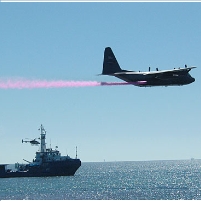BP Oil Spill Cleanup: Is the Solution Now Part of the Problem?
Friday, May 07, 2010

Considered the lesser of two evils by some environmentalists, the spraying of chemical dispersant into the Gulf of Mexico to break up the giant oil slick comes with its own risks and uncertainties for the environment.
So far, BP and the federal government have used more than 160,000 gallons of chemical dispersant in the sea to keep the crude oil from washing ashore along the Gulf coastline. Environmentalists have reluctantly gone along with the plan, believing it to be better than allowing the thick, toxic oil to inundate sensitive marshlands and other coastal habitat.
The problem is that no one outside of Nalco, the manufacturer of the dispersant Corexit, knows what exactly is in it, because the company refuses to disclose that information on grounds of protecting trade secrets.
Some biologists worry what the long-term effects might be on the Gulf, both from the presence of the oil and the chemicals used to fight it.
Others are wondering why Corexit is being used at all. These critics insist another, more effective dispersant is available. Made by the U.S. Polychemical Corporation, Dispersit reportedly was tested by the U.S. Environmental Protection Agency, which found the dispersant was far more effective than Corexit at breaking down crude oil.
The EPA also discovered Corexit was three times more deadly to silverfish, and two times more for shrimp, than Dispersit.
-Noel Brinkerhoff
In Gulf of Mexico, Chemicals Under Scrutiny (by Elisabeth Rosenthal, New York Times)
Toxic Oil Dispersant Used in Gulf Despite Better Alternative (by Brandon Keim, Wired)
- Top Stories
- Unusual News
- Where is the Money Going?
- Controversies
- U.S. and the World
- Appointments and Resignations
- Latest News
- Trump to Stop Deportations If…
- Trump Denounces World Series
- What If China Invaded the United States?
- Donald Trump Has a Mental Health Problem and It Has a Name
- Trump Goes on Renaming Frenzy






Comments